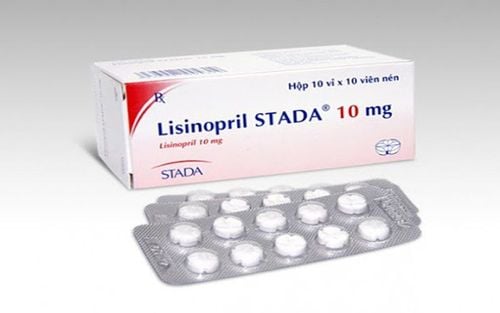This is an automatically translated article.
Carvas is a beta receptor blocker and an alpha 1 receptor blocker of the Adrenergic system. The drug is used in the treatment of cardiovascular diseases such as hypertension, heart failure and coronary artery disease. Let's find out more information about Carvas drug through the article below.
1. What is Carvas?
What is Carvas? Carvas medicine has the main active ingredient Carvedilol, which is prepared in the form of tablets with a strength of 6.25mg and 12.5mg.
Carvedilol works to reduce heart rate through inhibition of beta adrenergic receptors. At the same time, Carvedilol also acts on alpha-1 adrenergic receptors to help relax vascular smooth muscle, thereby reducing peripheral vascular resistance and reducing overall blood pressure.
When this drug is taken at higher doses, calcium channel blocking and antioxidant activity is also observed. The antioxidant effect of carvedilol blocks LDL oxidation and its uptake into the coronary circulation.
In the long-term treatment of patients with angina pectoris, carvedilol has anti-ischemic and analgesic effects. In patients with left ventricular dysfunction or congestive heart failure, when carvedilol has a favorable hemodynamic effect, the left ventricular ejection fraction is increased.
2. Indications and contraindications of the drug Carvas
Indications:
Carvas is used to reduce blood pressure, reduce heart rate and increase coronary circulation, so it is indicated for use in the following cases:
Hypertension: The drug can be used alone or in combination with other antihypertensive agents, especially in combination with thiazide diuretics. Treatment of heart failure: Carvedilol is indicated for use in combination with medicinal products such as digoxin, diuretics and/or angiotensin-converting enzyme inhibitors for the treatment of moderate to severe ischemic heart failure or myopathy. heart to slow disease progression. Angina: Helps reduce symptoms of chest pain and the risk of heart attack. Contraindications:
Carvas is contraindicated in the following cases:
Acute heart failure; NYHA class III - IV decompensated congestive heart failure has not been treated with a standard regimen. Asthma or bronchospasm because it can lead to an asthma attack. Cardiac shock; Severe bradycardia or conduction disturbances such as second- and third-degree atrioventricular block. Symptomatic or severe liver failure. Hypersensitivity to Carvedilol or to any of its ingredients.
3. Dosage and how to use Carvas
3.1 How to take Carvas medicine is taken orally, when taking it, the patient should take it at the same time of day to avoid forgetting the dose and ensure the drug concentration in the blood.
3.2 Dosage Adults:
Hypertension: Start with the first dose of 12.5 mg, once a day; After 2 days may need to increase to 25mg, once a day. Alternatively, the first dose is 6.25 mg orally twice a day, after 1 to 2 weeks increased to 12.5 mg, orally twice a day. If necessary, the dose may be increased further, at least 2 weeks apart, to a maximum of 50 mg once daily, or may be divided into several doses. For the elderly with hypertension, 12.5 mg orally once a day may be effective. Angina: Start with a dose of 12.5mg, twice a day; After 2 days can increase to 25mg, 2 times a day. Heart Failure: Before initiating carvedilol for congestive heart failure, patients should be treated for stable heart failure with standard regimens (cardiac glycosides, diuretics, and/or angiotensin-converting enzyme inhibitors). Oral with a dose of 3.125 mg / time and twice a day for 2 weeks. Thereafter, if the patient tolerates the dose, the dose can be increased to 6.25 mg twice daily. The dose may be increased gradually after 2 weeks intervals and up to a maximum of 25 mg orally twice a day for patients weighing less than 85 kg, severe heart failure or not exceeding 50 mg, orally twice a day for patients with severe heart failure. people weighing over 85 kg, mild and moderate heart failure. Patients with left ventricular dysfunction after myocardial infarction: Using a starting dose of 6.25 mg, twice a day, after 3 to 10 days, the dose can be increased to 12.5 mg, twice a day and the maximum dose. 25mg can be used, twice a day. Idiopathic cardiomyopathy: Use with a dose of 6.25-25 mg/time, twice a day. Children:
For children aged 2 to 18 years with heart failure, the starting dose is 50 mg/kg (maximum no more than 3.125 mg), twice daily for 2 weeks. Then, if tolerated, the dose can be increased to 350 mg/kg (maximum 25 mg), twice daily. 3.3 Overdose and missed dose Overdose:
Symptoms: Overdosage of carvedilol and some other beta-blockers often causes hypotension, bradycardia, heart failure, cardiogenic shock and possibly cessation heart. Carvedilol can also cause bronchospasm, vomiting, confusion, and generalized seizures when used in high doses. Overdose treatment: When there are symptoms of overdose or taking a larger dose than prescribed, the patient should be placed with his head low and taken to the emergency room. The patient must first undergo gastric lavage, then, depending on the signs of overdose, appropriate treatment steps will be taken. Missed dose: If you forget to take a dose, take it as soon as you remember. However, if it is almost time for your next dose, skip the missed dose. Do not take a double dose to make up for the missed dose.
4. Carvas . side effects
When taking the drug you may encounter the following side effects:
Common: Headache, muscle aches, fatigue, shortness of breath, dizziness, causing postural hypotension, nausea. Uncommon: Bradycardia, diarrhea, abdominal pain. Rare: Thrombocytopenia, leukopenia, decreased peripheral circulation, syncope, depression, sleep disturbances, paresthesias like crawling, vomiting, constipation, urticaria, pruritus, psoriasis; increased liver transaminases; reduce tear secretion prone to eye and nose irritation; stuffy nose. When experiencing unusual effects, you should notify your doctor for timely advice and treatment.
5. What should be noted when using Carvas
Use caution when using this drug in patients with congestive heart failure who are being treated with digitalis, diuretics, or angiotensin-converting enzyme inhibitors. While taking the drug, the patient was at greatest risk of developing decompensated heart failure and/or severe hypotension during the first 30 days of treatment. Therefore, it is necessary to monitor these signs during the initial period of taking the drug. If severe hypotension occurs, the patient should be placed with the head low and taken to a medical facility. Note when using the drug in patients with diabetes without or difficult to control. Discontinue treatment with Carvas when signs of liver damage appear. Use with caution in patients with peripheral artery disease, patients with anesthesia, patients with thyrotoxic syndrome. If the patient cannot tolerate or is contraindicated with other antihypertensive agents, very small doses of carvedilol can be used with caution in hypertensive patients with chronic obstructive pulmonary disease. When taking the drug to avoid abrupt discontinuation, the drug must be stopped for 1-2 weeks. The risk of arrhythmia must be considered if carvedilol is used concomitantly with volatile anesthetics. Pregnancy: Carvedilol has been shown to cause clinical harm to the fetus. This medicine should only be used during pregnancy if the potential benefit outweighs the potential risk and, as usual, should not be used during the last trimester of pregnancy or even near delivery. Undesirable effects reported in the fetus such as bradycardia, decreased blood pressure, respiratory depression, hypoglycaemia and the risk of hypothermia in the neonate may be due to the use of carvedilol in pregnant women. . For lactation: Carvedilol can be excreted in breast milk, but to date no adverse effects have been observed in the nursing infant. But it is necessary to prevent unwanted effects in nursing infants, it is best that nursing mothers should not take carvedilol or are taking drugs to stop breastfeeding.
6. Drug interactions
Some drugs that may interact with Carvas include:
Rifampicin when used concurrently can reduce the plasma concentration of carvedilol by up to 70%. The effect of beta-blockers including Carvas is decreased when combined with aluminum salts, barbiturates, calcium salts, cholestyramine, colestipol, alpha-1 receptor nonselective blockers, ampicillin, salicylates, and sulfinpyrazone by reducing bioavailability and plasma concentrations. Carvedilol may enhance the effect of antidiabetic drugs and increase the risk of excessive hypoglycemia, calcium channel blockers, digoxin. The interaction of carvedilol with clonidine can lead to an increase in blood pressure and a decrease in heart rate. Cimetidine may increase the effects and bioavailability of carvedilol. Other drugs that are also likely to increase the concentration and effect of carvedilol include quinidine, fluoxetine, paroxetine, and propafenone because these drugs inhibit CYP2D6. Carvedilol also increases digoxin levels by about 20% when taken at the same time. Be careful because there is a risk of Digoxin poisoning. Storage: You should keep Carvas medicine in a sealed package, away from moisture and away from direct light. Make sure the medicine is out of the reach of children.
Carvas drugs are used under the prescription and monitoring of the cardiologist, you must not arbitrarily use or stop taking the drug suddenly. Any unusual signs should be reported to the doctor to ensure safety.
Follow Vinmec International General Hospital website to get more health, nutrition and beauty information to protect the health of yourself and your loved ones in your family.













